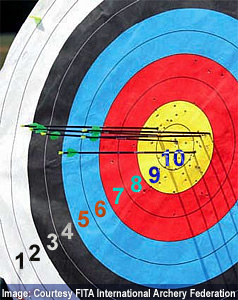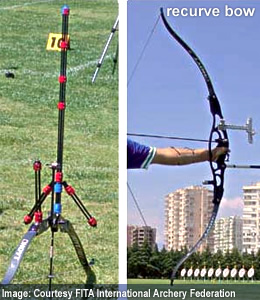|
Bhutan
at the Olympic Games |
 |
Bhutan Sports: Olympic Games |
|
 |
Bhutan Sports: Olympic Games |
|
|
 |
|
Olympic
Games: Archers' Equipment
|
|
Target
|
 |
 |
The target
face is 122 cm in diameter.
The
target face is attached to the target butt.
The
target face has 10 concentric scoring rings.
Each
ring is 6.1 cm in width. Hence, the inside scoring ring (the 10 ring) is
12.2 cm in diameter.
The
outside scoring ring is worth 1 point and the inside ring is worth 10 points.
There
are five colours on the target-white for the two outside rings (1
and 2-point rings), then black (3 and 4), light blue (5 and 6), red (7
and 8), and gold (9 and 10). Should an arrow land on the line dividing
two rings, it scores the higher score. |
|
 |
(Note:
within the 10 ring is a smaller, lighter circle called the X10. The very
centre of the target is called the bull's eye.)
The
target is positioned so that its centre is 130 cm above ground give or
take 5 cm.
A wind
flag is positioned above the centre of each butt. This flag is essential
to archers because wind affects their aim. A windsock is also visible on
the Field of Play.
|
Bows
|
 |
 |
| Two
kinds of bows are used during archery events, the recurve and compound
bows. During the Olympic Games, only
the recurve bow is allowed. Its limbs
curve away from the archer. It is also called a classic bow.
For
information, the compound bow has pulleys and cables to make the
holding weight less than half of the draw weight. It is a very precise
and competitive bow that also provides exciting matches during World
Championships and World Cups.
The
bow is constructed of high-tech material. Modern risers (handles)
are usually made of aluminium or carbon fibre; the limbs are laminated
fibreglass, carbon fibre and a wood or synthetic core. The string is a high-strength, lowstretch material. |
|
Other
features on a bow include a stabilizer, a sight, upper and lower limbs,
a handle riser, a grip, a nock point, an arrow rest, a plunger button and
a clicker.
|
Arrows
|
 |
Arrows
are usually made of a combination of aluminium and carbon fibre.
The arrowhead or point is the part of the arrow that sticks into the target.
The nock is the end of the arrow that fits onto the bow string.
The feathers on an arrow are called the fletching or fletch.
Every
arrow must be identified with an archer's name or initials.
Arrows
can fly close to 250 km/h with a recurve bow.
|
|
London
2012 Olympic Games
|
 |
Archery
was a sport in the Olympic Games from 1900-1920. In 1972, archery became
a permanent part of the Olympic programme.
There
are 64 men and 64 women competing in the recurve division, for individual
and team events in London. There will be four new Olympic Champions: Individual
Men, Individual Women, Team Men, and Team Women.
In
the Ranking Round, the athletes shoot 72 arrows at a distance of
70 metres. In the Olympic Round (matches), the number 1 individual
qualifier (seed) shoots against number 64, and so on ...
In
the individual matches, athletes alternate shooting 12 arrows -
4 ends of 3 arrows. They have 30 seconds to shoot each arrow and earn a
maximum of 10 points per arrow. Winners advance to the next round.
Each
nation that qualified three athletes of the same gender can also compete
in the team competition.
In
the team matches, each team shoots 24 arrows-4 ends of 6 arrows.
They have only 2 minutes in which to shoot 6 arrows. Each team member shoots
2 arrows per end, shooting only one arrow at a time. Teams alternate shooting
after every 3 arrows.
 |
| Source:
International Archery Federation FITA 2012 |
 |
 |
External
links |
 |
 |
World
Archery |
International
Archery Federation FITA |
|
|




